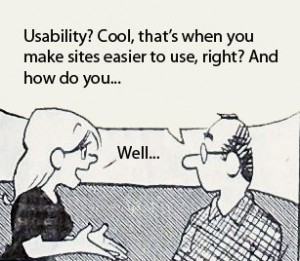Lately, website usability is the favorite subject for a lot of people I talk to. They feel the need to improve their sites, to make them easier and more pleasant to use, to increase their conversion rates or just want to know more about what I do here at Avangate.
Knowing that getting on the road is the most difficult part, I thought I might share with you a list of 3 people that played the most important roles in my usability “education” so far, the gurus that should not be missed by usability apprentices and, in a few words, what I have learned from each of them.

So, here they are:
1. Steve Krug
 “Don’t make me think” (2001 edition), written by Steve Krug, was one of the first books I read on the subject and although some argue that it’s only light knowledge, it really made a difference for me. With a strong focus on ecommerce websites, he uses the hypermarket analogy, showing how you should connect the user experience with your website with the offline hypermarket one.
“Don’t make me think” (2001 edition), written by Steve Krug, was one of the first books I read on the subject and although some argue that it’s only light knowledge, it really made a difference for me. With a strong focus on ecommerce websites, he uses the hypermarket analogy, showing how you should connect the user experience with your website with the offline hypermarket one.
I also learned the lesson of length: after finishing writing a review, audit or other usability (and not only!) assessment documents, I must cut the text in half and then get rid of half of what’s left. So, thank him for the shortness of this blog post :) .
Then, he taught me not to be a hater, which basically means to cut loose the unconstructive critic and make efforts to learn something useful from each mistake I see web designers doing.
2. Jakob Nielsen
 Being the author of the Useit.com alertbox, he is surely the first name that comes in mind when asking a usability specialist about a guru of this business – and yes, Google mind works in the same way. Nielsen taught me that some things never change. In spite of the speed of technology progress, when it comes to usability, you know that facts such as a good link or url will always be good the way we know them now.
Being the author of the Useit.com alertbox, he is surely the first name that comes in mind when asking a usability specialist about a guru of this business – and yes, Google mind works in the same way. Nielsen taught me that some things never change. In spite of the speed of technology progress, when it comes to usability, you know that facts such as a good link or url will always be good the way we know them now.
Although Nielsen is often referred to as being conservative, and even if he is on a lot of issues, I learned from him that usability and creativity go hand in hand and that they should do that. They just have to never forget the power of testing when trying new approaches and to always do their best to coexist in harmony.
3. Luke Wroblewski
 His book “Web form Design. Filling in the blanks” is one of my recent readings with an impact on how I look at forms to fill in on the web. Although my intuition about forms was not that bad, this book made me understand the reasons behind the usability rules in designing them.
His book “Web form Design. Filling in the blanks” is one of my recent readings with an impact on how I look at forms to fill in on the web. Although my intuition about forms was not that bad, this book made me understand the reasons behind the usability rules in designing them.
So, testing shows that vertical aligned forms are filled in faster, while horizontal ones slower. That’s why the latter is good choice when it comes to forms with sensitive data, like credit card details. Testing also reveals how you may improve with up to 40% chances that the Where did you hear about us question: by placing it on the thank you page. But of course, it depends…
Well, if it’s about forms, Luke Wroblewski is my guy.
These are my champions so far that I could name on usability issues. Besides all these theoretical recommendations let me conclude with a short list of resources o practical tips and examples:
- Design versus art blog points to a practical example of how a small change in design may improve usability.
- Getelastic examples of applied “don’t make me think” approach.
- Smashing magazine with a very good list of usability and interaction books.
- Adaptive Path presenting one of their most interesting projects, Aurora.
- JustAddWater Blog article about 2 different download buttons strategies with pros and cons
May thy users browse happily ever after! :)
What about your favorite experts and resources?





